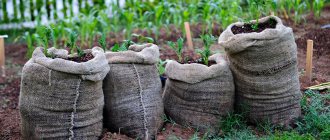Of more than a dozen tuberous plants of the New World, only potatoes and Jerusalem artichoke have reached us. But if Jerusalem artichoke remained more of an overseas delicacy, or even a malicious weed of summer cottages, then potatoes not only arrived - they marched in victory! In the Soviet comedy “Girls,” Toska selflessly recalls potato dishes, but that list is far from complete. But what's the point of listing various delicacies when potatoes are the basis of our diet? Perhaps this is the reason for the variety of methods of cultivating crops in summer cottages.
Preparing to plant potatoes
Potatoes grow almost anywhere, but it is preferable to plant them in fertilized, light, well-drained soils. To improve the composition of clay soils in summer cottages, experienced gardeners recommend adding sand. To obtain consistently good potato yields, it is necessary to add manure, potash fertilizers or ash to the soil.
In addition, according to agricultural technology, it is not recommended to plant potatoes in the same areas for several years in a row. Pathogens, Colorado potato beetle larvae and other pests persist in the soil. If you constantly fertilize the land, add peat-humus mixtures, manure, and periodically update seed material, you can plant potatoes in the same place for several years, but all these measures are not as effective as following the principles of crop rotation. Root crops are best grown on virgin lands.
When intensively cultivating a summer cottage, the best predecessors of potatoes are legumes. It also grows well after rye, legumes - vetch, alfalfa. Potatoes feel great after rapeseed and white mustard. The use of these crops as green manure not only enriches the soil with mineral compounds, but also prevents the spread of diseases and pests.
Research conducted at the Agricultural Academy named after K.A. Timiryazev, showed that adding a mass of green manure to the soil gives the same effect as half-rotted manure. Among vegetables, the best predecessors of potatoes turned out to be root vegetables (carrots, beets, radishes), cucumbers and other pumpkin crops. Experts do not recommend planting potatoes after cabbage.
To harvest a good potato harvest, you need to prepare the area and tubers for planting
Regardless of the method of planting potatoes, you need to carefully select the tubers. The seed material must be extremely healthy, the tubers clean and dry, without areas of rotting. After sorting the tubers, they begin to germinate them. This is not necessary, but it allows you to speed up the time of appearance of the first shoots after planting the potatoes in the ground, and also makes it possible to once again select the best tubers, discarding those that form eyes too slowly or produce weak, thin seedlings.
For germination, it is recommended to keep the tubers in a sufficiently lit room at a temperature of +12–15°C for 2–4 weeks. At this time, some gardeners treat the tubers with growth stimulants and weak fertilizer solutions. Tubers are often disinfected and treated with various means to prevent potato diseases.
The proven folk method of disinfection with ash is still successfully used to this day. A bucket of water is poured into 1 kg of ash, and the tubers are dipped into this solution before planting. There are many other ways to process potatoes both before germination and before planting: for example, use a solution of phytosporin or complex preparations such as Prestige, Maxim.
Potatoes are planted in the ground only after making sure that the soil has warmed up to +6–7°C 10 cm deep. Planting at lower temperatures, up to +3–5°C degrees, is used only for sprouted tubers. Early and very early potato varieties are also planted in unheated soil; the result will be better than with later planting.
In addition to temperature, it is important to consider arable suitability. The soil is considered ready if it crumbles well and its density is low, this ensures good access of oxygen to the germinating tubers.
Depending on the composition of the soil and the location of the site, the timing of planting potatoes may vary. More fertile lands need to be sown earlier, since tubers with a high nutrient content develop more slowly and require more time to ripen. On light soils, southern slopes and at higher elevations, it is also advisable to start planting potatoes earlier.
The process of planting potatoes is a sequence of stages:
- Preparing the soil in accordance with the chosen method of planting potatoes.
- Pre-planting preparation of tubers (sorting, germination, processing of seed material).
- Planting potatoes taking into account the maturity of the soil and the degree of its warming.
In the future, you only need to provide the plants with adequate watering, regular loosening of the soil and destruction of weeds.
What is the depth?
The planting depth of tubers is usually divided into three categories, each of which is more suitable for a specific soil type:
- Deep. In this case, the size of the holes is 12 cm or more. Sometimes it reaches 20 or 30 cm. This option is practiced when growing crops on land with high fertility; it is practiced where there is little rainfall. Deep planting is suitable for black soils.
- Average. This method is practiced when cultivating potatoes in peat areas and sandy loam soils. This option can also be used for black soils. Tubers are buried to a depth of 7-10 cm.
- Small. With this planting, the holes are 5-6 cm in size. This is the best option when growing potatoes on very dense soils, for example, loam. It is difficult for sprouts to break through. Also, a small amount is used when planting in unheated soil.
In the garden, you should adhere to approximately the same depth for planting tubers, then the area will be easier to cultivate. In addition, for faster germination, you should use processed and sprouted potatoes.
To do this, a month before planting, they are disinfected by keeping them in a solution of potassium permanganate with a concentration of 1% for 30 minutes. The potatoes are then laid out in a single row in a well-lit room to allow them to green up. Then he will not be afraid of germs and mice. Also, the room should be cool. To maintain the required humidity, the potatoes are periodically irrigated with a spray bottle. Before planting (2 days before), the potatoes are sprayed with a solution of Heteroauxin. On the day of planting, sprinkle with wood ash.
Traditional planting methods
The usual methods of planting potatoes are quite varied: at least five methods can be distinguished on how to do this.
Planting under a shovel in single ridges and double rows
Environmental conditions, climate and soil conditions determine the choice of potato planting method: ridge or smooth. Moisture from the soil evaporates less with smooth planting, for which:
- The site is dug up in advance, often in the fall.
- A thick cord or twine attached to pegs indicates the direction of the rows at a distance of 70 cm from each other. Using a plow you can do it faster.
The plow makes the gardener’s work easier and faster
Dig holes at a distance of 25–30 cm with a depth of half a spade, lay the seed material and fill the previous hole with soil from the new one. It is more convenient for two people to plant potatoes: one digs holes, the other plants the tubers and adds ash if necessary, and the first one fills this hole, thereby digging a new one. Then the ground is leveled with a rake.
Continuous planting of potatoes - video
As a result of ridge planting, full air access to the soil and its warming are ensured. This method is recommended for use when groundwater is high on heavy loams. In areas of good and excessive moisture, the ridges are cut in the fall after applying organic fertilizers.
The uneven surface of the soil accumulates heat, which during cold weather it releases to the adjacent layer of air, creating comfortable conditions for potato growth.
The optimal row spacing for ridge planting is 70 cm. The ridges are formed at a height of 12–15 cm, and the depth of planting of tubers is 6–8 cm. Naturally, the larger the tubers, the greater the depth; small tubers do not need to be planted deeply. Holes are dug at a distance of 25–30 cm from the edge of the ridge, so that there is something to hill up the potatoes with later. 25–30 cm are also left between them. If the soil is not very well fertilized, the feeding area should be larger.
An original version of ridge planting of potatoes - video
Popular potato varieties:











